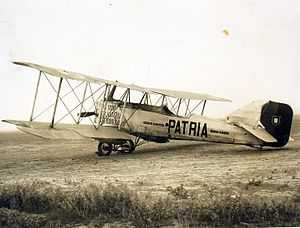Breguet 16
| 16 | |
|---|---|
 | |
| Portuguese Bre16Bn.2 "Patria" | |
| Role | Night bomber |
| Manufacturer | Breguet |
| Designer | Marcel Vuillierme |
| First flight | 1 June 1918 |
| Introduction | 1921 |
| Retired | 1926 |
| Number built | ca. 200 |
|
| |
The Breguet 16 was a bomber biplane produced in France toward the end of World War I.
Design and development
Design of the Breguet 16 was essentially a scaled-up version of Breguet's highly successful 14 - a conventionally configured biplane with two-bay, unstaggered, equal-span wings. Trials in 1918 proved highly promising, and production in mass by several French manufacturers under licences from Breguet was planned for 1919. These plans were discarded upon the Armistice, but more limited production was revived in the early 1920s as the French Air Force began a programme of modernisation.[1]
Operational history
In service, the single-engine Breguet 16 was used to replace obsolete twin-engine Farman F.50s in the night bomber role as the Bre.16Bn.2. Some of the 200 aircraft built were deployed to Syria and Morocco, and Breguet also managed to sell some to the military air arms of China and Czechoslovakia.[2]
Variants
- Bre.16Bn.2
- Night bomber version.
Operators
- Chinese Nationalist Air Force
Specifications
General characteristics
- Crew: Two, pilot and observer
- Length: 9.55 m (31 ft 4 in)
- Wingspan: 16.96 m (55 ft 8 in)
- Height: 3.32 m (10 ft 11 in)
- Wing area: 75.5 m2 (813 ft2)
- Empty weight: 1,265 kg (2,789 lb)
- Gross weight: 2,200 kg (4,850 lb)
- Powerplant: 1 × Renault 12Fe, 224 kW (300 hp)
Performance
- Maximum speed: 160 km/h (99 mph)
- Range: 900 km (559 miles)
- Service ceiling: 4,600 m (15,090 ft)
Armament
- 1 × trainable 7.7 mm (.303 in) Lewis Gun in observer's cockpit
- 550 kg (1,213 lb) of bombs
See also
- Aircraft of comparable role, configuration and era
References
| Wikimedia Commons has media related to Breguet 16. |
Notes
Bibliography
- Taylor, John W. R. and Jean Alexander. Combat Aircraft of the World. New York: G.P. Putnam's Sons, 1969. ISBN 0-71810-564-8.
- Taylor, Michael J. H. Jane's Encyclopedia of Aviation. London: Studio Editions, 1989. ISBN 0-517-69186-8.
- World Aircraft Information Files. London: Bright Star Publishing, File 890, Sheet 80–81.
| ||||||||||||||||||
| ||||||||||||||||||||||